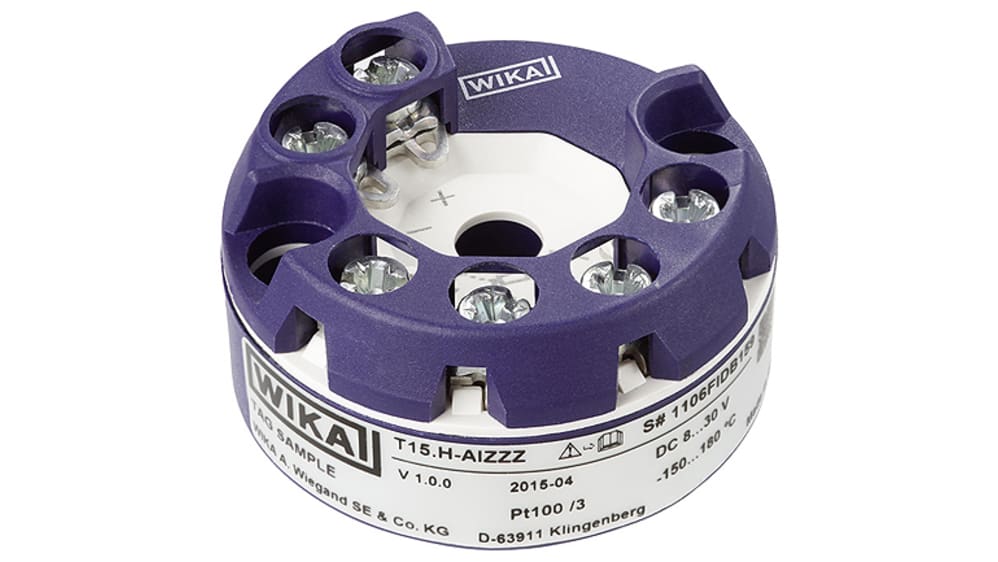Temperature transmitters might not be the first thing that comes to mind when you think about industrial equipment, but they’re actually a big deal when it comes to keeping things running smoothly. These handy devices convert temperature readings from the sensors into electrical signals that are easy to read and control. In industries like food processing, oil and gas, or even pharmaceuticals, having accurate temperature data is essential for both safety and efficiency.
This ultimate guide will explore the world of temperature transmitters in detail, offering insights into their working principles, types, and various applications. Whether you are looking to optimize your processes, reduce energy consumption, or improve overall system performance, understanding the role of temperature transmitters is key to achieving precision and efficiency in your operations.
Let’s dive in and uncover the factors that influence their selection, performance, and cost-effectiveness in industrial settings.
What is a Temperature Transmitter?
A temperature transmitter is a crucial device used to convert temperature readings from sensors, such as thermocouples or RTDs (Resistance Temperature Detectors), into standardized electrical signals. These signals are typically in the form of a 4-20mA output or digital protocols like HART or Modbus.
The transmitter’s job is to take the raw data from the sensor and make it readable and usable for control systems, monitors, or other automation equipment. This conversion is essential because temperature sensors alone can’t send out data in a format that’s easy to interpret and act upon by the larger control system.
These devices are commonly used in processes where precise temperature control is critical—such as in chemical manufacturing, food processing, or HVAC systems.
By converting temperature data into a standardized signal, transmitters enable better control, data analysis, and automation, ultimately improving efficiency and performance across a wide range of industries.

Temperature Transmitter Working Principle
A temperature transmitter is a crucial device used to convert temperature readings from sensors, such as thermocouples or RTDs (Resistance Temperature Detectors), into standardized electrical signals. These signals are typically in the form of a 4-20mA output or digital protocols like HART or Modbus.
Here’s an explanation of how a temperature transmitter works to understand the process:
- Temperature Sensor Input:
- The process begins with a temperature sensor (e.g., thermocouple or RTD). The sensor detects temperature changes in the environment.
- It converts the temperature reading into a small electrical signal (analogue signal) that represents the measured temperature.
- Signal Processing:
- The small electrical signal from the sensor is not sufficient for accurate reading and control. The transmitter amplifies this signal to make it stronger and more stable.
- It may also filter out noise or unwanted variations from the signal to ensure accuracy.
- Signal Conversion:
- After processing, the transmitter converts the amplified signal into a standardized output format, such as a 4-20 mA current signal or a digital protocol like HART or Modbus.
- This standardized output ensures the signal is compatible with control systems and can be transmitted over long distances without losing integrity.
- Transmission to Control System:
- The standardized output is sent to the control system or monitoring equipment, where the temperature can be monitored and regulated.
- Control systems can use the temperature data to make real-time adjustments to the process, ensuring temperature stays within desired ranges for optimal performance and safety.

Types of Temperature Transmitters
When it comes to choosing a temperature transmitter, it’s important to understand that different types are designed to meet specific needs and application environments.
The right choice depends on factors like installation space, communication requirements, and the complexity of the monitoring system.
Let’s take a look at the different types of temperature transmitters and their unique features.
- Head-Mounted Transmitters: Installed directly on the temperature sensor, these are compact and ideal for limited spaces.
- DIN-Rail Transmitters: Mounted on DIN rails in control panels, these are suitable for centralized installations.
- Wireless Transmitters: Offer remote monitoring by transmitting signals wirelessly, reducing installation costs.
- Smart Transmitters: Equipped with advanced features like diagnostics and digital communication protocols (e.g., HART or FOUNDATION Fieldbus).
Each type has its unique advantages, making it essential to select the right one based on your application requirements.
Temperature Transmitter HS Code
When it comes to international trade and customs, understanding the HS Code (Harmonized System Code) for temperature transmitters is essential for proper classification and smooth import/export processes. The HS Code for temperature transmitters typically falls under 9025.19.80, which is categorized as “Instruments and apparatus for measuring or checking temperature, not elsewhere specified or included.” This code helps ensure that temperature transmitters are correctly classified for tariff purposes and makes the shipping process more straightforward across borders.
Temperature Transmitter Range
Temperature transmitters are designed with various ranges to meet the needs of different applications. Standard temperature transmitters usually cover a range of -50°C to 150°C, making them suitable for a wide range of industrial processes. However, for specialized applications that require extreme temperatures, transmitters can be found with ranges that extend from -200°C to 850°C or even higher.
It’s essential to choose a transmitter with a range that matches your specific requirements. Selecting the correct range ensures that the transmitter performs accurately within your process parameters, helping to maintain precise control over temperature and providing the safety and efficiency of your operation. Whether you need a standard or high-temperature solution, picking the right transmitter will maximize performance and reliability.
Applications of Temperature Transmitters
Temperature transmitters are crucial in industries that require precise temperature control. Here are some key applications:
- Oil and Gas: Used to monitor temperatures in pipelines, storage tanks, and refinery equipment, helping prevent issues like corrosion and unsafe pressure levels.
- Pharmaceuticals: Essential for maintaining precise temperatures during production, ensuring the quality and efficacy of sensitive products like vaccines.
- Food and Beverage: Help maintain consistent temperatures during processing and storage, ensuring food safety and quality.
- HVAC Systems: Regulate environmental conditions in buildings, factories, and facilities, ensuring efficient heating, cooling, and ventilation.
These applications highlight how temperature transmitters ensure operational safety, quality, and efficiency across various sectors.
Tips for Choosing the Right Temperature Transmitter
Selecting the right temperature transmitter is key to achieving optimal performance in your applications.
Here are a few tips to guide your decision:
- Define Your Requirements: Understand the specific temperature range, accuracy, and environmental conditions of your application. Whether you’re dealing with extreme temperatures or need precise measurements, defining these needs will help you choose the right transmitter.
- Consider Communication Protocols: Ensure that the temperature transmitter is compatible with your control system, such as HART, Modbus, or other digital protocols. The right communication protocol ensures seamless integration and efficient data transfer.
- Evaluate Durability: If your process operates in harsh or extreme environments (e.g., high vibration, corrosive substances, or high temperatures), choose a temperature transmitter designed for durability and resistance to these conditions.
- Choose Trusted Brands: Opt for temperature transmitters from well-established brands like WIKA, which are known for their proven quality, reliability, and customer support. Trusted brands often offer better long-term performance and technical assistance.
By keeping these factors in mind, you can select a temperature transmitter that best suits your application, ensuring reliable, accurate, and efficient temperature monitoring across your processes.
Your Input Matters – Share Your Needs
Popular Brands: Temperature Transmitter WIKA
WIKA is a leading brand in the temperature transmitter market, offering a range of reliable and durable transmitters for various applications, including industrial, laboratory, and specialized sectors. Known for their precision and high-quality engineering, WIKA transmitters are widely used across industries like oil and gas, pharmaceuticals, and food processing.
WIKA offers models with HART communication protocols, ideal for advanced monitoring and control. They also provide transmitters designed for use in hazardous environments, ensuring safety and efficiency in challenging conditions. Depending on the model and features, WIKA transmitters in India can be priced from ₹10,000 to ₹50,000, making them a solid choice for businesses seeking reliable temperature measurement solutions.
Temperature Transmitter Price (Indian Market)
The price of temperature transmitters in the Indian market varies depending on factors such as the brand, type, temperature range, and advanced features. Basic models can start at around ₹3,000 to ₹4,000, offering reliable performance for less complex applications. However, more advanced or smart transmitters, which include features like digital communication protocols (HART, Modbus), high-temperature ranges, or specialized designs, can range anywhere from ₹15,000 to ₹40,000 or more.
Conclusion
Temperature transmitters are essential components in many industries, ensuring precise temperature control, safety, and efficiency. From monitoring critical temperatures in oil and gas to maintaining strict conditions in pharmaceuticals and food processing, these devices play a vital role in enhancing operational performance. By understanding the working principles, types, and applications of temperature transmitters, you can make informed decisions that improve the reliability and efficiency of your operations.
If you’re looking for expert advice or need high-performance temperature transmitters, look no further than MTC (Machine Tools Centre). As a leading distributor of automation solutions, we offer top-tier products and services tailored to your unique needs. Whether you’re upgrading your equipment or starting a new project, our team is here to help you find the perfect temperature transmitter for your operations.
Contact MTC today for more information on temperature transmitters and other automation solutions that can elevate your business performance!
FAQs (Frequently Asked Questions)
Is an RTD a Temperature Transmitter?
No, an RTD (Resistance Temperature Detector) is a temperature sensor. However, it works in conjunction with a temperature transmitter to convert the temperature data into a readable signal.
Where Are Temperature Transmitters Used?
Temperature transmitters are used in industries like oil and gas, pharmaceuticals, food and beverage, HVAC systems, and chemical manufacturing to monitor and control temperature accurately.
What Are the Three Types of Temperature Transmitters?
The three main types are:
- Head-mounted transmitters (mounted directly on the sensor)
- DIN-rail transmitters (mounted in control panels)
- Wireless transmitters (offer remote monitoring)
What is the Purpose of a Temperature Transmitter?
A temperature transmitter converts temperature readings from sensors into standardized electrical signals, making it easier for control systems to interpret and act on the data.
How Does a Temperature Transmitter Work?
A temperature transmitter receives data from a sensor, amplifies and processes the signal, and then converts it into a standardized format (like 4-20mA or digital protocols) to communicate with control systems.




